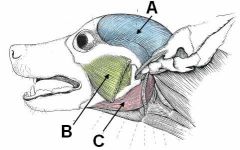I’m a foodie. Heaven knows I love some scrumptious delights to please my palate. What if the simple action of chewing delectable morsels caused excruciating pain? This dreaded scenario happens for some dogs, and is called masticatory myositis. Pain while chewing is often chalked up to dental problems. Many pet parents don’t know about this painful muscle problem, so I wanted to devote time this week to spreading some information about it. Happy reading!
Masticatory Myositis – What is it?
Chewing is an intricately coordinated process. The medical term for chewing is mastication. Several important muscles in mastication, and are collectively called muscles of mastication. These muscles include the temporalis, digastricus, masseter, and pterygoid muscles.

All muscles contain fundamental structures called myosin fibers. There are several types of myosin fibers. The muscles of mastication have some unique myosin fibers called 2M fibers. Patients living with masticatory myositis develop marked inflammation in their chewing muscles because the immune system attacks the 2M fibers. The body creates special proteins called antibodies that target specific components of the 2M fibers, including myosin heavy chain, myosin light chain 2-masticatory (LC2-M), and masticatory myosin binding protein-C (mMyBP-C). Additionally, serotonin may promote fibrosis (scarring) in the muscles of mastication.
Masticatory Myositis – What does it look like?
Any dog can develop masticatory myositis, although large breeds are affected most often. Some breeds are over-represented, including:
- Doberman pinschers
- Cavalier King Charles spaniels
- German shepherd dogs
- Rottweilers
- Golden retrievers
- Labrador retrievers
In general, there is no sex or age predisposition. However, Cavalier King Charles spaniels have been diagnosed with this condition as young as 12 weeks of age. Initially the muscles of mastication swell and are excruciatingly painful. The swelling can push the eyes partially out their sockets (called exophthalmos); occasionally the optic nerve is damaged, resulting in blindness. Affected dogs can’t or are unwilling to open their mouths. As such, their appetites may be decreased. As the disease progresses, the 2M fibers are replaced with scar tissue. The result of this scarring is an often marked shrinking (called atrophy) of the muscles of mastication. Concurrently, the eyes may appear sunken in their sockets (called enophthalmos). Severely affected patients develop trismus, an ability to open their mouths

Masticatory Myositis – How is it diagnosed?
A veterinarian will recommend diagnostic testing to confirm a diagnosis of masticatory myositis. Initially non-invasive blood and urine testing should be performed the measure specific muscle enzymes (e.g.: creatine kinase | CK | CPK; aspartate aminotransferase | AST) and white blood cells (e.g.: eosinophils) to screen for other conditions that have similar clinical signs. Such health problems include:
- Muscular dystrophy
- Dislocation of temporomandibular joint (the “jaw”)
- Retrobulbar (behind the eye) tumor or abscess
- Tetanus
- Polymyositis
- Foreign object in the muscle of the jaw
- Craniomandibular osteopathy (growth abnormality of the jaw bones)
A simple blood test is also available to measure 2M antibodies. Occasionally, advanced imaging (computed tomography | CT scan; magnetic resonance imaging | MRI) and muscles biopsies are required for definitive diagnosis.
Masticatory Myositis – How is it treated?
As this condition is caused by an inappropriate attack by the immune system, medications that change how the immune system responds are the mainstay of treatment. Many different immunomodulatory drugs are available, and no specific protocol has been shown to be superior to date. Common therapies include:
- Corticosteroids (i.e.: prednisone | prednisolone, dexamethasone)
- Azathioprine
- Cyclosporine
- Mycophenolate mofetil
Given the discomfort these patients experience, aggressive multimodal pain control is of paramount importance. Affected dogs may prefer to eat moist foods, and some require gruels because they are unable to open their jaws. Severely affected patients often require supplemental feeding tubes to receive adequate nutrition. Dog parents may find it helpful to partner with a board-certified veterinary internal medicine specialist who can help them develop a logical and cost-effective treatment plan. Early identification and treatment is essential because patients with extensive muscle fibrosis have poorer prognoses.
The take-away message about masticatory myositis in dogs…
The immune system can attack and damage a dogs’ chewing muscles. This condition is called masticatory myositis, and it is very painful. Early identification and intervention are needed to maximize the likelihood of a meaningful response. Therapies are aimed at thwarting the immune system attack, relieving pain, and ensure adequate nutritional support.
To find a board-certified veterinary internal medicine specialist, please visit the American College of Veterinary Internal Medicine.
Wishing you wet-nosed kisses,
cgb





